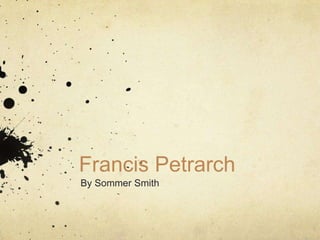
Francis Petrarch: Poet, Scholar of the Renaissance
- 1. Francis Petrarch By Sommer Smith
- 2. Born in 1304 in Arezzo, Italy Petrarch was born at the beginning of the Renaissance. He became a widely known scholar, humanist, and poet.
- 3. Petrarch spent time studying in Montpellier for several years, then moved on to study in Bologna for two years. He took an interest in writing, Latin literature, and law.
- 4. Father of Humanism “Five enemies of peace inhabit with us / avarice, ambition, envy, anger , and pride; if these were to be banished, we should infallibly enjoy perpetual peace.”
- 5. Easter Sunday, 1341 Petrarch was invited to Rome. On this day he was crowned publicly as the poet Laureate and historian in the Capitol.
- 6. Fame and Fortune Petrarch was most proud of his writings in Latin, especially his epic poem Africa. Ironically, his most read and well-loved works are his sonnets, which he considered trifling. He often wrote about human emotion.
- 7. Petrarch wrote sonnets, essays, and poems by the hundreds, but two of his most famous are the “Trionfi” and the “Canzoniere.” The “Trionfi” is a moral allegory, featuring six figures: Love, Chastity, Death, Fame, Time, and Divinity; the former being ultimately triumphant. The “Conzoniere” is a compilation of sonnets with themes of love and patriotism.
- 8. Meeting Laura On April 6, 1327 Petrarch was attending church at Sainte- Claire d'Avignon. There it is said he first met a young woman by the name of Laura, the “most beautiful woman he had ever seen.” There has been some debate as to whether Laura actually existed, but some historians are able to identify her with the wife of Hugues de Sade
- 9. You’re the inspiration… Whether fabricated or not, Laura inspired many of Petrarch’s most famous lyrics and even provided the inspiration for many of the pieces in the “Canzoniere.” If Laura truly existed Petrarch’s love went unreciprocated and no relationship ever came from his obsession.
- 10. July 18, 1374 Petrarch died in Arqua. He left behind his writing, and an influence on writing and literature for hundreds of years to come.